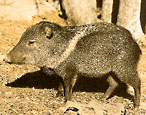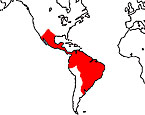|
Collared
Peccary
(Pecari tajacu) #63-445 |
||||
|
|
Physical
characteristics and distribution
|
|
Collared Peccary Tayassu tajacu Collared Peccaries resemble pigs in general appearance but the distinguishable difference is that peccaries have a vestigial tail, and their hind feet have only three toes rather than four. The coats of Collared Peccaries are bristly and black with a yellowish-white band around the shoulders. Their head and body length ranges from 750-1,000 and can weigh 14-30 kg. They grab food with their snout. They mainly eat cactus fruit, berries, tubers, bulbs, and rhizomes but they will also eat snakes and other small vertebrates. Collared Peccaries, like pigs, are not dirty animals; on the contrary, they are quite clean animals. Their habit of pawing sand against their belly with the front feet serves as a way a cleaning themselves. The speed and agility of Collared Peccaries render them more than a match for dogs, coyotes, and bobcats. They have fair hearing, poor vision, and good smelling abilities. They are gregarious animals. Group sizes ranges from 2-50 individuals with both sexes included in the groups. The mating season is not restricted to a certain time of year. The gestation period lasts about 150 days with the females giving birth to at least 2 young. The young are born in a thicket, hollow log, cave, or a burrow; with the intent to shelter and hide young from predators like the jaguar or puma. Collared Peccaries are located in the USA (mainly in Arizona and Texas), Mexico (outside the Sierra Madre), and all other Central American states; South America in N Argentina, Bolivia, Brazil, Columbia, Ecuador, French Guiana, Guyana, Paraguay, Peru, Surinam, Trinidad, and Venezuela; and have also been introduced to Cuba. They live in a great variety of habitats, including desert scrub, arid woodland, and rainforest. They shelter in a thicket, under a large boulder, or in limestone caves. |
|
Description
of the brain
|
|
Animal
source and preparation
|
|
All
specimens collected followed the same preparation
and histological procedure.
|
Other Related Resources (websites and publications)
List of Specimens | Explore Collections | Brain Sections | Brain Evolution | Brain Development | Brain Circuitry | Brain Functions | Location and Use | Related Web Sites | Contact Us | Search MSU Database | Personnel | Home


